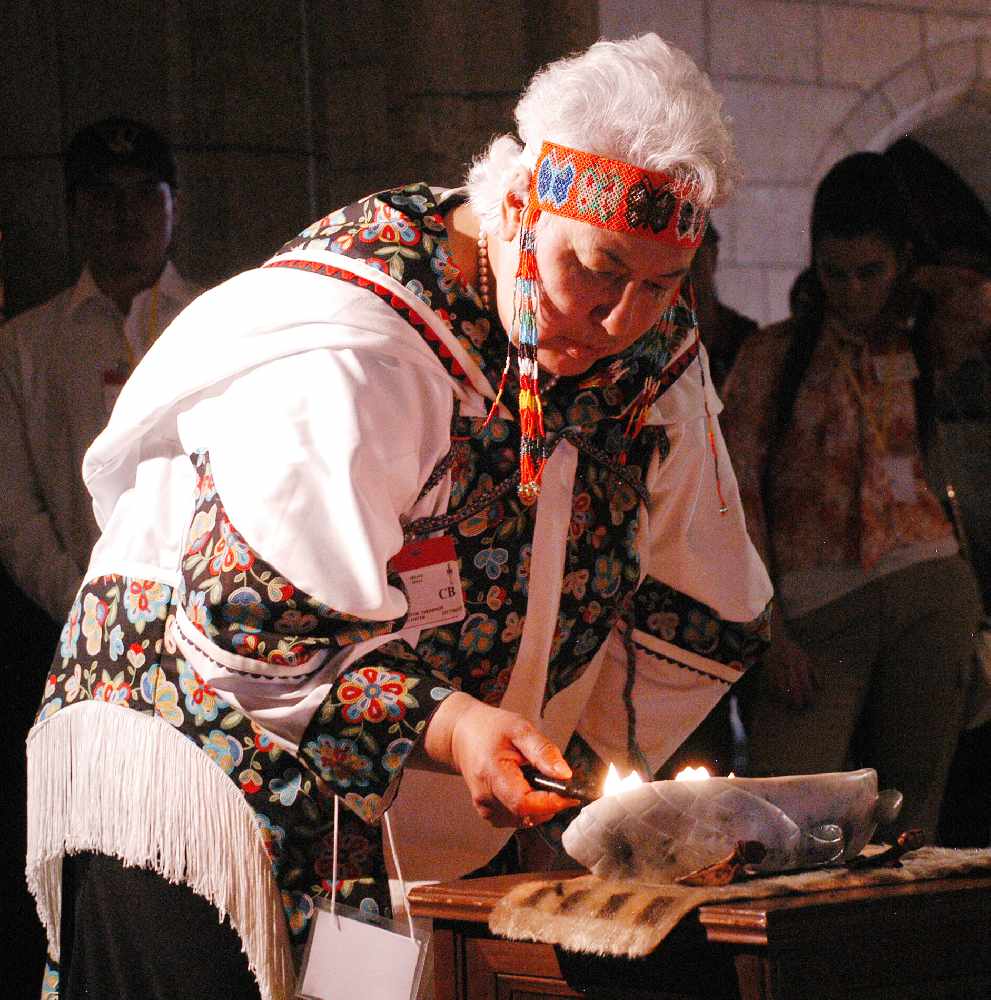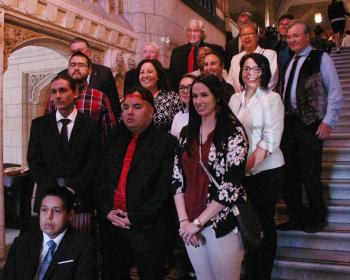Image Caption
Summary

Inuk elder lights a ceremonial qullik
By Brett Forester
Windspeaker.com Contributor
OTTAWA
On June 7, the Senate Standing Committee on Aboriginal Peoples, in partnership with local charity Youth Ottawa, invited Indigenous Elders and youth to Parliament Hill.
Indigenous and non-Indigenous students, youth community leaders, and activists filled the Red Chamber and Senate foyer with the aim of “Indigenizing the Senate.”
The event was hosted as part of the committee’s current, ongoing study into a new relationship with First Nations, Métis, Inuit, and Canada.
Former chief commissioner of the Truth and Reconciliation Commission and current member of the Standing Committee, Senator Murray Sinclair said the study was currently in its first of three phases.
“The first phase is going to focus on the history of the relationship between First Nations, Métis, Inuit, and the newcomers. Phase two is going to be looking at the principles of what our new relationship will look like. Phase three is going to explore how we can apply those principles to specific issues for Indigenous peoples in Canada.”
In preparation for the event, the Senate communications department called on communities to nominate impactful youth leaders. Of the 110 nominations received, the Senate Committee chose nine Indigenous youth leaders to testify before the committee.
Saskatchewan Senator Lillian Dyck is the committee chair, and also the first female Indigenous senator and first Canadian born Chinese senator in history. She said the nine youth chosen to testify were selected due to their outstanding community involvement and activism.
“They’ve made their mark in bringing together different parts of the community, and (have) become leaders within their own community.” The committee further intended to provide “equal representation between the three major Indigenous groups, between male and female, and between areas of the country,” Dyck said.
The youth chosen are:
· Andrea Andersen, 25, Makkovik, Nunatsiavut (now resides in Iqaluit, Nunavut)
· Jacquelyn Cardinal, 26, Treaty 8 Territory, Alta. (now resides in Edmonton, Alta.)
· Perry Kootenhayoo, 30, Alexis Nakota Sioux First Nation, Alta. (now resides in Edmonton, Alta.)
· Modeste McKenzie, 22, La Ronge, Sask. (now resides in Northern Village of Air Ronge, Sask.)
· Tiffany Monkman, 30, Winnipeg, Man.
· Jennifer O’Bomsawin, 22, Odanak, Que.
· Valerie Ooshag, 20, Thunder Bay, Ont. (now resides in Eebametoong First Nation, Ont.)
· Stephen Puskas, 34, Yellowknife, N.W.T. (now resides in Montreal, Que.)
· Holly Jane Sock, 26, Elsipogtog First Nation, N.B. (now resides in Tobique First Nation)
· Chris Tait, 25, Gitxsan Nation, B.C. (now resides in Vancouver, B.C.)
In a symbolic occupation of space, the event began with a land acknowledgment ceremony by an Indigenous youth leader in the Senate foyer, followed by smudge and qulliq lighting ceremonies facilitated by a Cree and Inuk Elder respectively.
The group then moved into the Red Chamber itself for welcoming speeches by Dyck, Sinclair, and Nunavut Senator Dennis Patterson.
Youth leaders and senators then participated in a KAIROS blanket exercise, which the KAIROS website describes as “a teaching tool to share the historic and contemporary relationship between Indigenous and non-Indigenous peoples in Canada.”
Finally, later this evening, the youth leaders give direct testimony to the Committee on Aboriginal Peoples from 6:45 p.m. to 8:45 p.m. (EDT) Watch the event live at http://senparlvu.parl.gc.ca/XRender/en/PowerBrowser/PowerBrowserV2/20170607/-1/6886?useragent=Mozilla/5.0%20(Macintosh;%20Intel%20Mac%20OS%20X%2010_12_5)%20AppleWebKit/537.36%20(KHTML,%20like%20Gecko)%20Chrome/58.0.3029.110%20Safari/537.36
In his welcoming address to the youth gathering, Sinclair projected hope and optimism for the future.
“You are growing up with more knowledge about these issues than I ever was at your age. You are more aware of things that are going on. You now have information at your disposal to understand what the relationship is like today and how things came to be the way they are.”
He encouraged the youth leaders to share their honest dreams, visions, and aspirations with the Committee.
“Those dreams are essential to the development of a new relationship between Canada and Indigenous peoples. Those ideas are for you to share with each other and with us. Your visions of what Canada can be, and what our relationship could and should be like, need to be heard. We will listen to you.”
However, the Senate Committee does not have any executive power or control over federal Indigenous policies. According to Dyck, the committee can only pressure Minister of Indigenous and Northern Affairs Carolyn Bennet to adopt its recommendations.
“A lot of people,” Dyck stated, “academics or other leaders – AFN or whoever – can say what they want but they can’t actually make the minister respond, whereas we can. That is a good pressure tactic, and public pressure is an important lever. Depending on what’s going on politically, it can be very important.”
Dyck said she hopes that this study, along with the committee’s work in general, will help close the gaps between Indigenous peoples and Canada on issues like access to health care, child support services, racism, and education.
“Among the public, we, unfortunately, do have racism toward Aboriginal people,” Dyck said. “This kind of study, I think, will help that in the long run because it’s going to educate people.”
Ultimately, she voiced her confidence in the youth leaders themselves. “They will bring us different ideas. They come at it from a different way. They haven’t been burnt out. They’re more optimistic. They’re more creative.”
“Who knows,” she added. “Maybe one of them will get to be the Prime Minister.”
The projected release date for the entire report is not yet available.

